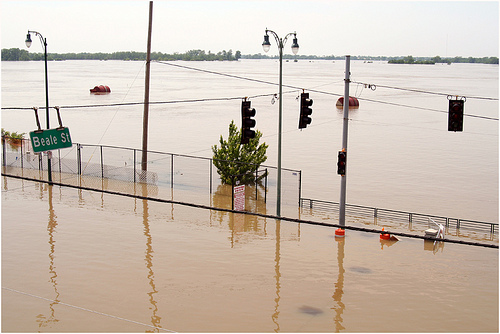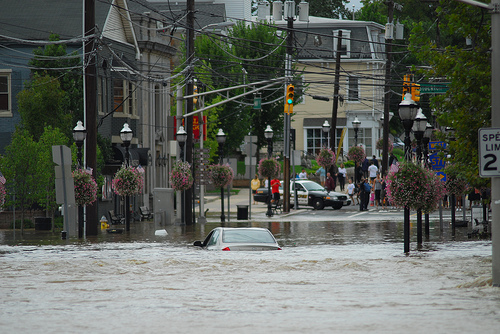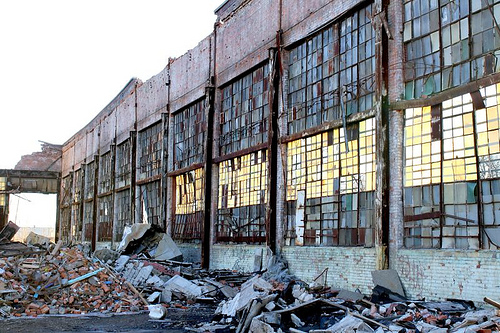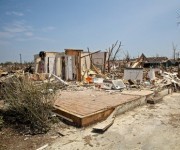 Memphis flood. Photo: Chris WielandBy many measures, 2011 was the most extreme weather year for the United States since reliable record-keeping began in the 19th century — and the costs have been enormous. According to the National Oceanic and Atmospheric Administration (NOAA), 2011 set a record for the most billion-dollar disasters in a single year. There were 12, breaking the old record of nine set in 2009. The aggregate damage from these 12 events totals at least $52 billion, NOAA found.
Memphis flood. Photo: Chris WielandBy many measures, 2011 was the most extreme weather year for the United States since reliable record-keeping began in the 19th century — and the costs have been enormous. According to the National Oceanic and Atmospheric Administration (NOAA), 2011 set a record for the most billion-dollar disasters in a single year. There were 12, breaking the old record of nine set in 2009. The aggregate damage from these 12 events totals at least $52 billion, NOAA found.
Severe weather across much of the nation has raised the question of whether global warming has already begun to influence shorter-term weather patterns, raising the specter of even more extreme years to come as global temperatures continue to rise.
According to climate studies, the short answer is yes: The new climate environment created by global warming is making some extreme events, particularly heat waves and heavy rain, more likely to occur and more intense when they do. Climate models have more difficulty predicting how climate change may be influencing other types of extremes, such as severe thunderstorms and tornadoes, but a warming climate provides more fuel to these events in the form of increased water vapor and heat in the atmosphere.
Throughout 2011, searing heat waves, parching drought, deadly tornadoes, blizzards, and floods cost billions of dollars in damage, affected millions of lives, and killed more than a thousand people across the United States.
Climate Central examined extreme weather events from coast to coast to determine the 10 states that were clobbered the worst. Texas tops that list, with a costly — and deadly — combination of intense drought, a punishing heat wave, the worst wildfires in state history, and plenty of tornadoes. Rounding out the top 10 were Alabama, Missouri, North Carolina, Oklahoma, Tennessee, Kansas, Connecticut, Vermont, and New Jersey.
Climate Central’s analysis factored the death toll in each state, damage costs, the disruption caused to daily life, and how unusual the events were compared with what transpires in an average year.
1. Texas
 A wildfire rages behind Bastrop, Texas.Photo: Joe WolfTexas was hit by eight of the nation’s billion dollar disasters — the most of any state in the country. Of the eight, the three most devastating were drought, heat, and wildfires. The drought still grips the state, and it is the most intense one-year drought on record. Unlike past dry periods, the damage to the state has been aggravated by record-breaking heat. Groundwater levels in much of the state have fallen to their lowest levels in more than 60 years, according to observations from NASA satellites.
A wildfire rages behind Bastrop, Texas.Photo: Joe WolfTexas was hit by eight of the nation’s billion dollar disasters — the most of any state in the country. Of the eight, the three most devastating were drought, heat, and wildfires. The drought still grips the state, and it is the most intense one-year drought on record. Unlike past dry periods, the damage to the state has been aggravated by record-breaking heat. Groundwater levels in much of the state have fallen to their lowest levels in more than 60 years, according to observations from NASA satellites.
The heat during the summer of 2011 was relentless, with many cities smashing records for the longest stretch of 100-degree days, including Dallas with a record 70 straight days with 100-degree heat, and San Angelo with a whopping 98 days above 100. July 2011 was the hottest month ever recorded statewide, and Amarillo, Texas, reached 111 degrees F on June 26, an all-time record high for that location where records date back to 1892.
The combination of drought and unusually hot conditions during this summer helped fuel massive wildfires, and the 2011 wildfire season was the worst in Texas’ history, with about 4 million acres burned from November 2010 through November 2011, causing $750 million in damage and killing 10 people, including four firefighters.
Lake and reservoir levels have fallen so low that they are revealing entire towns flooded decades ago at the bottom of lakes and reservoirs. Ranchers have been forced to sell off large portions of their herds early, which is likely to raise beef prices by reducing future beef supplies.
2. Alabama
Alabama was ground zero for the largest tornado outbreak in American history, when more than 100 twisters gouged paths across the state in late April, killing 240 people.
Some of the most intense tornadoes flattened heavily populated areas. One twister, shown nationally on live TV, tore through downtown Tuscaloosa and went on to destroy parts of Birmingham. Another monster EF-5 twister, with winds stronger than 200 mph, tracked across northern Alabama, killing 78 people, becoming one of the deadliest single tornadoes in modern American history.
According to the Storm Prediction Center, Alabama saw the most tornadoes of any state this year, with 170. The staggering death toll and damage these storms caused led to a wave of Alabama state pride, with the mantra “We are Alabama” spreading throughout social media networks in the storms’ wake.
3. Missouri
 Joplin, Mo.Photo: John MorrisonMissouri was the site of America’s worst tornado disaster since 1950, when a massive tornado, nearly a mile wide, wiped large portions of the city of Joplin off the map on May 22. With winds greater than 200 mph, that tornado killed nearly 160 people, making it the seventh deadliest in U.S. history.
Joplin, Mo.Photo: John MorrisonMissouri was the site of America’s worst tornado disaster since 1950, when a massive tornado, nearly a mile wide, wiped large portions of the city of Joplin off the map on May 22. With winds greater than 200 mph, that tornado killed nearly 160 people, making it the seventh deadliest in U.S. history.
Tornadoes were just one prong of the deadly onslaught of extreme weather in Missouri, as a combination of heavy spring rains and upstream snowmelt sent the Missouri and Mississippi Rivers surging over their banks. According to NOAA, in an average year, the Missouri River channels 24.8 million acre feet of water. This year, it carried 24.3 million acre feet in May and June alone. When the Army Corps of Engineers essentially blew up the levees to save the small town of Cairo, Ill., floodwaters inundated around 130,000 acres of Missouri farmland.
4. North Carolina
April 2011 was the most active tornado month in U.S. history with 753 tornadoes. North Carolina was among the states worst hit. On April 16, multiple tornadoes ripped through Raleigh and nearby towns, leaving a trail of destruction behind them. Thirty-eight people died in a two-day April tornado outbreak that spread through 10 states; 22 were in North Carolina.
North Carolina was also one of the first states walloped by Hurricane Irene in August. With its immense 450-mile span, the storm battered the North Carolina coast with rain and driving 60-80 mph winds for nearly 12 hours. Half a million people lost power during the storm, and the gusting winds generated waves high enough to demolish piers and damage homes along the coastline. All told, the cost to North Carolina from tornadoes and Irene is estimated at $3.2 billion.
5. Oklahoma
In 2011, Oklahomans suffered through a brutal combination of severe drought and intense heat, the likes of which have not been seen since the infamous Dust Bowl era of the 1930s. The Sooner State had the hottest summer of any state in U.S. history, narrowly beating neighboring Texas, and eclipsing a record that dated to 1934. Oklahoma’s average day and nighttime temperature during July was a scorching 88.9 degrees F, the warmest in any state during any month on record.
For an idea of how hot it was in Oklahoma last summer, consider this: In Grandfield, the temperature reached or exceeded 100 degrees on a record-setting 97 days from mid-April to Sept. 1.
On top of record heat, last February, the state froze its way through the coldest temperature on record: -31 degrees F, and the state’s heaviest 24-hour snowfall on record, when 27 inches fell in the town of Spavinaw.
And if that wasn’t enough, Oklahomans also struggled with other weather hazards, including the largest hailstone in state history, some of which measured half a foot in diameter.
6. Tennessee
The good news for Tennessee this year was that the drought that plagued states to the southwest — Texas, Oklahoma, and Kansas — didn’t make it up this far. But for the Volunteer State, a little more drought might have been a good thing. On April 30, Nashville was drenched with more than six inches of rain, followed the next day by more than seven inches — the third heaviest and worst single-day rainfall, and the worst two-day rainfall, in the city’s history. It was even worse in Camden and Brownsville, Tenn., with more than 17 inches of rain over the same period. By May 2, it was already the rainiest May on record.
Not surprisingly, the record rains led to massive flooding on the Cumberland, Harpeth, and Duck rivers, killing 23 people. The estimated property damage in Nashville alone topped $1.5 billion.
Deadly as they were, the floods weren’t the only lethal weather to strike Tennessee during the spring. Just a week or so before the deluge came, the state was hit with an EF-5 tornado — the most powerful rating there is — smashing through Apison, killing 13. It was part of a wider outbreak that killed more than 300 people across the southeast. When you add in the heat wave that blasted most of the eastern half of the U.S. in July, the total damage from weather and climate-related disasters added up to nearly $4 billion.
7. Kansas
 Clinton Lake.Photo: Patrick EmersonThe massive heat wave and drought that devastated Texas and Oklahoma didn’t hit Kansas quite as hard, but it was bad enough to help push the Jayhawk State into the top 10 this year. By midsummer, much of the southwestern part of the state was suffering under “exceptional drought” conditions — it ended up being the ninth driest year ever recorded — and by year’s end, there was still no relief in sight. Wichita had more 100-degree-plus days than any year on record, beating out even the Dust Bowl summer of 1936.
Clinton Lake.Photo: Patrick EmersonThe massive heat wave and drought that devastated Texas and Oklahoma didn’t hit Kansas quite as hard, but it was bad enough to help push the Jayhawk State into the top 10 this year. By midsummer, much of the southwestern part of the state was suffering under “exceptional drought” conditions — it ended up being the ninth driest year ever recorded — and by year’s end, there was still no relief in sight. Wichita had more 100-degree-plus days than any year on record, beating out even the Dust Bowl summer of 1936.
As of May, the state had seen unusually few tornadoes, but that didn’t last: powerful thunderstorms, tornadoes, and punishing hail swept the state in June, July, and August. To top it all off, a 5.6-intensity earthquake struck on Nov. 5. The quake didn’t cause much damage, but combined agricultural losses from the heat and drought topped $4 billion.
8. Connecticut
Snowstorms aren’t usually news in Connecticut — but 2011 was hardly usual. Hartford was buried under a record-setting 57 inches of snow in January, making it the all-time snowiest month in state history. Then, nearly two months before the next winter began, Connecticut was blasted by the worst October snowstorm in 200 years. The heavy wet snow, which cost the state more than $500 million, sent trees and tree limbs falling onto power lines, leaving more than 700,000 people without heat or lights. In the worst power failure in state history, many didn’t get their electricity back for more than a week.
In August, tropical storm Irene pummeled the state with heavy rains and gale-force winds that caused devastating floods and turned the lights out on more than 650,000 people. Some areas were pounded with as much as eight inches of rain in just 24 hours.
9. Vermont
Just as most of the Northeast thought they had escaped the worst of Irene’s wrath, the super-saturated tropical storm ravaged Vermont. The furious rains battered more than 2,000 roads spanning 500 miles in the state, paralyzing commerce, stranding people, and demolishing thousands of homes and businesses. More than 175 roads were completely destroyed and have only been rebuilt months later in what has been described as a model of fast-paced recovery from a disaster.
This all came after one of the snowiest winters on record, which produced record snowmelt. In May, heavy rain and all that melting snow drove Lake Champlain to its highest level on record, flooding several nearby towns. Record-setting rains helped set the stage for Irene’s damage by saturating the ground and putting streams and rivers at unusually high levels when the storm arrived.
Vermont officials say the total damage costs from Irene will be between $175 and $250 million.
10. New Jersey
 Photo: jay greinskyHurricane Irene roared into New Jersey to become one of the state’s deadliest and costliest storms, as well as the state’s wettest storm in more than a century. Tropical downpours sent rivers and streams overflowing, with nine rivers rising to their highest level ever. The flooding closed 300 roads and highways and interrupted train service for days.
Photo: jay greinskyHurricane Irene roared into New Jersey to become one of the state’s deadliest and costliest storms, as well as the state’s wettest storm in more than a century. Tropical downpours sent rivers and streams overflowing, with nine rivers rising to their highest level ever. The flooding closed 300 roads and highways and interrupted train service for days.
The bill for hurricane damage in New Jersey stands at $1.4 billion already, and at least seven people died during the storm. Then, two weeks later, a second round of drenching rain — the remains of Tropical Storm Lee — swept across the state, triggering even more flooding. All told, it was the wettest August and September New Jersey has seen in 117 years.
Just as the Garden State began to dry out, a freak autumn snowstorm hit over the Halloween weekend. The wet, heavy snow stuck to leaves that hadn’t fallen from the trees. The result: falling branches that blocked roads and downed power lines, leaving half a million people without electricity, some of them for a week.



